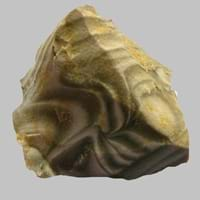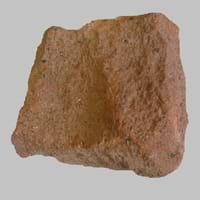Definition
Flint is a hard type of sedimentary rock that produces a small piece of burning material when hit by steel
Ignimbrite is a volcanic rock consisting mainly of pumice fragments, formed by the consolidation of material deposited by pyroclastic flows
Origin
Unknown
New Zealand
Discoverer
Unknown
Patrick Marshall
Etymology
From Old English flint - a type of rock mainly known for high hardness and for giving off sparks when struck
From Latin ignis fire + imber, imbr- shower of rain, storm cloud + -ite
Class
Sedimentary Rocks
Igneous Rocks
Sub-Class
Durable Rock, Hard Rock
Durable Rock, Medium Hardness Rock
Group
Not Applicable
Volcanic
Other Categories
Fine Grained Rock, Opaque Rock
Fine Grained Rock, Opaque Rock
Texture
Banded, Rough
Aphanitic
Color
Black, Brown, Green, Grey, Red, White
Beige, Black, Brown, Grey, Pink, White
Durability
Durable
Durable
Scratch Resistant
Yes
Yes
Appearance
Glassy or Pearly
Dull, Vesicular and Foilated
Interior Uses
Decorative Aggregates, Homes, Interior Decoration
Decorative Aggregates, Floor Tiles, Homes, Interior Decoration
Exterior Uses
As Building Stone, As Facing Stone, Garden Decoration, Office Buildings, Paving Stone
As Building Stone, Garden Decoration, Office Buildings, Paving Stone
Other Architectural Uses
Curbing
Curbing
Construction Industry
Arrowheads, Cutting Tool, Spear Points
Building houses or walls, Construction Aggregate
Medical Industry
Not Yet Used
Not Yet Used
Antiquity Uses
Artifacts
Artifacts, Monuments, Sculpture, Small Figurines
Commercial Uses
Creating Artwork, Gemstone, In fire-starting tools, Manufacture of tools, Metallurgical Flux, Jewelry, To ignite fire, Used in flintlock firearms
Cemetery Markers, Commemorative Tablets, Creating Artwork
Types
Not Available
Not Available
Features
Clasts are smooth to touch, Easily splits into thin plates, Has High structural resistance against erosion and climate
Always found as volcanic pipes over deep continental crust
Archaeological Significance
Monuments
Not Yet Used
Used
Famous Monuments
Not Applicable
Data Not Available
Sculpture
Not Yet Used
Used
Famous Sculptures
Not Applicable
Data Not Available
Pictographs
Not Used
Used
Petroglyphs
Not Used
Used
Figurines
Not Yet Used
Used
Formation
Flint is formed by the decomposition and compaction of various organisms such as sponges and diatoms under the water.
Ignimbrites are formed from very poorly sorted mixture of volcanic ash or tuff and pumice lapilli, commonly with scattered lithic fragments.
Mineral Content
Silicon
Apatite, Biotite, Calcite, Chlorite, Feldspar, Hematite, Hornblade, Ilmenite, Magnetite, Olivine, Pyroxene, Quartz
Compound Content
Silicon Dioxide
Ca, NaCl
Types of Metamorphism
Not Applicable
Burial Metamorphism, Contact Metamorphism, Hydrothermal Metamorphism, Impact Metamorphism, Regional Metamorphism
Types of Weathering
Not Applicable
Biological Weathering, Chemical Weathering
Types of Erosion
Chemical Erosion, Coastal Erosion, Water Erosion
Chemical Erosion, Coastal Erosion
Grain Size
Very fine-grained
Fine Grained
Fracture
Conchoidal
Uneven
Porosity
Highly Porous
Highly Porous
Luster
Vitreous
Vitreous to Dull
Cleavage
Non-Existent
Not Available
Toughness
1.5
Not Available
Specific Gravity
2.5-2.8
2.73
Transparency
Translucent to Opaque
Opaque
Density
2.7-2.71 g/cm3
1-1.8 g/cm3
Resistance
Heat Resistant, Impact Resistant, Pressure Resistant, Wear Resistant
Heat Resistant, Impact Resistant, Pressure Resistant, Wear Resistant
Deposits in Eastern Continents
Asia
Azerbaijan, China, Russia
Afghanistan, Armenia, Azerbaijan, Burma, Cambodia, China, India, Indonesia, Iran, Japan, Malaysia, Mongolia, Nepal, North Korea, Pakistan, Saudi Arabia, Syria, Taiwan, Thailand, Turkey, Vietnam, Yemen
Africa
Not Yet Found
Cameroon, Cape Verde, Chad, Djibouti, Eritrea, Ethiopia, Kenya, Libya, Madagascar, Nigeria, Rwanda, South Africa, Sudan, Tanzania, Uganda
Europe
Austria, Belgium, Cyprus, Denmark, France, Germany, Italy, Malta, Netherlands, Poland, Portugal, Romania, Spain, Sweden, Switzerland, Turkey, Ukraine, United Kingdom
France, Georgia, Germany, Greece, Iceland, Italy, Netherlands, Poland, Portugal, Spain, United Kingdom
Others
Not Yet Found
Antarctica, Hawaii Islands
Deposits in Western Continents
North America
USA
Canada, Costa Rica, Panama, USA
South America
Bolivia
Argentina, Bolivia, Brazil, Chile, Colombia, Ecuador
Deposits in Oceania Continent
Australia
New Zealand, South Australia
Central Australia, Western Australia
Flint vs Ignimbrite Characteristics
Though some rocks look identical, they have certain characteristics which distinguish them from others. Characteristics of rocks include texture, appearance, color, fracture, streak, hardness etc. Flint vs Ignimbrite characteristics assist us to distinguish and recognize rocks. Also you can check about Properties of Flint and Properties of Ignimbrite. Learn more about Flint vs Ignimbrite in the next section. The interior uses of Flint include Decorative aggregates, Homes and Interior decoration whereas the interior uses of Ignimbrite include Decorative aggregates, Floor tiles, Homes and Interior decoration. Due to some exceptional properties of Flint and Ignimbrite, they have various applications in construction industry. The uses of Flint in construction industry include Arrowheads, Cutting tool, Spear points and that of Ignimbrite include Building houses or walls, Construction aggregate.
More about Flint and Ignimbrite
Here you can know more about Flint and Ignimbrite. The life cycle of a rock consists of formation of rock, composition of rock and transformation of rock. The composition of Flint and Ignimbrite consists of mineral content and compound content. The mineral content of Flint includes Silicon and mineral content of Ignimbrite includes Apatite, Biotite, Calcite, Chlorite, Feldspar, Hematite, Hornblade, Ilmenite, Magnetite, Olivine, Pyroxene, Quartz. You can also check out the list of all Sedimentary Rocks. When we have to compare Flint vs Ignimbrite, the texture, color and appearance plays an important role in determining the type of rock. Flint is available in black, brown, green, grey, red, white colors whereas, Ignimbrite is available in beige, black, brown, grey, pink, white colors. Appearance of Flint is Glassy or Pearly and that of Ignimbrite is Dull, Vesicular and Foilated. Properties of rock is another aspect for Flint vs Ignimbrite. The hardness of Flint is 7 and that of Ignimbrite is 4-6. The types of Flint are Not Available whereas types of Ignimbrite are Not Available. Streak of rock is the color of powder produced when it is dragged across an unweathered surface. The streak of Flint and Ignimbrite is white. The specific heat capacity of Flint is 0.74 kJ/Kg K and that of Ignimbrite is 0.20 kJ/Kg K. Depending on the properties like hardness, toughness, specific heat capacity, porosity etc., rocks are resistant to heat, wear, impact, etc.Flint is heat resistant, impact resistant, pressure resistant, wear resistant whereas Ignimbrite is heat resistant, impact resistant, pressure resistant, wear resistant.





